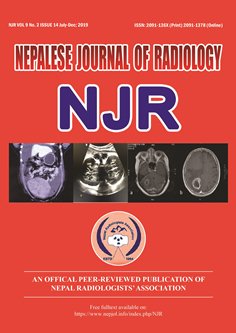Prevalence and Spectrum of Fetal Congenital Anomalies: A Hospital Based Study from Mid-Western Part of Nepal
DOI:
https://doi.org/10.3126/njr.v9i2.27413Keywords:
Birth Defects, Gestational Age, Hydrops FetalisAbstract
Introduction: To estimate the prevalence and pattern of congenital anomalies through obstetric ultrasound on pregnant women visiting Rapti sub-regional hospital, Ghorahi, Dang, Nepal.
Methods: A descriptive cross sectional study was conducted among 10,380 pregnant women visiting Radiology department of Rapti sub-regional hospital from January 2016 to July 2017. The findings of transabdominal ultrasonography (USG) performed by Radiologist and information regarding women’sage and gestational age were recorded. The images of any significant cases were also saved. Data wereanalyzed based on study objectives using descriptive statistics such as frequency, percentage, mean, rangeand standard deviation. The classification of the malformation was done based on the anatomical system.
Results: Out of 10,380 ultrasound performed during the study period, 106 (1.02%) pregnant women presented with different congenital anomalies. The antenatal prevalence of congenital anomalies was 10.21 per 1000 pregnant women. The mean maternal age was 25.9 ± 4.80 years. Regarding gestation age, 87 (82.1%) anomalies were detected at second trimester of pregnancy. Most commonly involved body system was central nervous system 51 (48.1%), followed by cardiovascular system 12 (11.3%), musculoskeletal system 10 (9.4%), gastrointestinal system 5 (4.7%), respiratory system 5 (4.7%), genitourinary system 4 (3.8%). Other anomalies were cystic hygroma 9 (8.4%), hydrops fetalis 4 (3.8%), cleft lip 3 (2.8%), pelvic cystic lesion 2 (1.8%) and conjoined twins 1 (0.9%).
Conclusion: The prevalence of congenital anomalies is high in mid-western part of Nepal. Central nervous system anomalies were more common than other anomalies.
Downloads
Downloads
Published
How to Cite
Issue
Section
License
This license enables reusers to distribute, remix, adapt, and build upon the material in any medium or format, so long as attribution is given to the creator. The license allows for commercial use.




